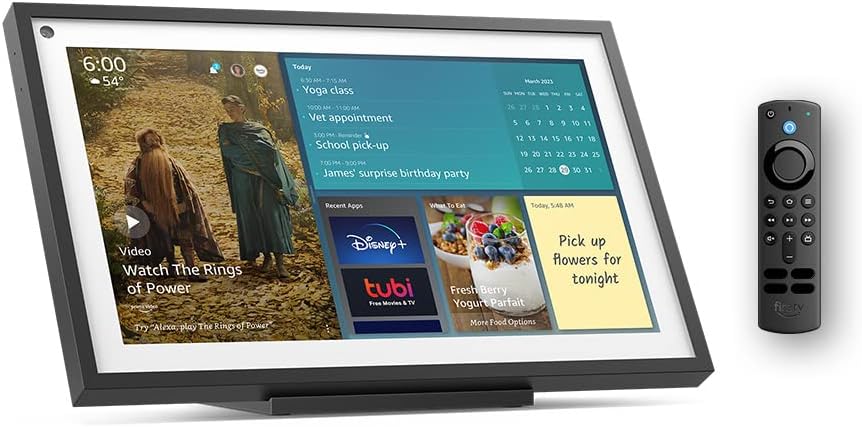What is Matter Casting and Which Devices Support It?
You’ve probably used Chromecast or AirPlay, or any of the other wireless video casting systems. They’re useful for sharing media on your mobile device to a TV, whether video or photos. Smart home protocol Matter has its own casting technology, Matter Casting.

Please note: This page may contain affiliate links. Read our ethics policy
You’ve probably used Chromecast or AirPlay, or any of the other wireless video casting systems. They’re useful for sharing media on your mobile device to a TV, whether video or photos. Smart home protocol Matter has its own casting technology, Matter Casting.
An open standard for streaming media to a smart TV or streaming stick, Matter Casting has been embraced by Amazon, and is already available on the Echo Show 15.
What is Matter Casting?

Open-source video streaming technology Matter Casting is part of the Matter specification. Its main purpose, as described in the Matter 1.2 Core Specification document [PDF] is to relay information from endpoints (the various smart home and IoT devices using the Matter standard) for display. Consequently, a TV or other display may be referred to in documentation as an “exposed entity.”
At present, multiple proprietary casting solutions have made it difficult for any single smart home system to take advantage. This has implications beyond notifications and finding out what is on TV. For example, you may require footage from a video baby monitor or pet cam to be sent to your smart home display.
Replacing AirPlay and Chromecast (and less popular alternatives such as DLNA/UPNP and Miracast) with this open-source standard makes sense, not least as it will improve and standardize voice control for casting services.
How Does Matter Casting Work?
As with other wireless video streaming technologies, Matter Casting particularly relies on Wi-Fi.
For manual use, you will need a mobile device running and app that supports Matter Casting and a suitable display. Finally, both devices should be connected to the same Wi-Fi network.
At the time of writing (April 2024), the casting technology is only supported in Amazon’s Prime Video app. To use it from a mobile device, open the app, select a video, tap the casting button, and select the appropriate device.
You can also tap Learn more about casting to confirm which devices are currently compatible.
Which Devices Currently Support Matter Casting?

Where can you use Matter Casting? Currently, just one device that features Matter Casting is available. The Amazon Echo Show 15 smart display can receive video streamed to it from an Android or iOS mobile device. While this 15.6-inch display might seem a bit small, other Amazon products (Fire TV boxes and streaming sticks) are expected to include the technology soon.
In addition, Panasonic TVs that have Fire TV built-in should also include Matter Casting.
As use of the Matter protocol spreads, so should take up of Matter Casting. However, Amazon appears to be its biggest cheerleader at this time, with no other major streaming services currently indicating support for Matter Casting.
Beyond Amazon Prime, Matter Casting is set to arrive on Plex and Pluto TV, along with three smaller services: Sling TV, STARZ, and ZDF. However, none of these have confirmed a date for adopting Matter Casting.
Benefits of Using Matter Casting
The main advantage of Matter Casting is that it is likely to be adopted across all smart home platforms. As more include Matter support, so Matter Casting will become more prevalent.
Its presence on Matter goes beyond simply providing an alternative to Chromecast and AirPlay. Matter Casting is intended as an information sharing medium, a method to display updates (occasional or live) from smart home equipment on any connected display.
So, you could watch TV and view the temperature and other environment data from a sensor in your kitchen. Or you could stream live video direct from a security camera (once that device type is better supported) when an alert is received. It will also end that annoying scenario when you’re casting from an iPad over AirPlay and are unable to do anything else with the device.
The potential for Matter Casting is considerable, and given the comparative limitations of Chromecast and AirPlay, it seems likely to be around for some years to come.
Some Limitations of Matter Casting
An open platform that enables all devices to speak to each other and communicate relevant information to your TV screen pushes us towards the futuristic smart home promise.
While Matter Casting is currently limited to the Amazon Prime Video app and a single Amazon smart screen (the Echo Show 15), its use is simple enough to be incorporated into other streaming services.
However, at this time, no other major services have announced Matter Casting support, which seems to be its key shortcoming.
On the other hand, even if it doesn’t make an impact with subscription streaming services, casting will still be present in the Matter protocol. It’s how camera-equipped IoT and smart home devices (or endpoints) will stream video to a compatible display (or “exposed entity”).
About the Author

Christian Cawley
Editor in Chief
Christian has been writing about technology since the mid 2000s, and has been published in numerous publications, online and in print. These include Android Magazine, Linux User & Developer, Linux Format, Tech Radar, Tom's Hardware, and Computer Active. From 2014-2024, he was a section editor and later deputy editor at MakeUseOf, before joining the Matter Alpha team. Christian enjoys old video games (mainly C64, Amiga, and MS-DOS), classic TV, and telling everyone who will listen that they should have a robot cleaner. When he's not shaping articles, Christian is a dad to three dancers, collects Lego, and is an avid home chef.